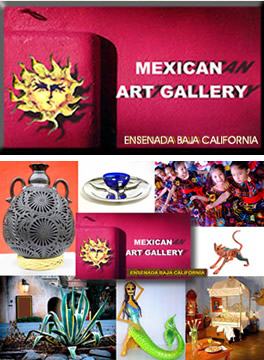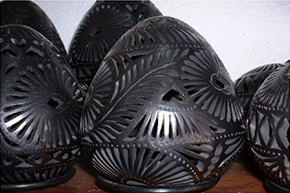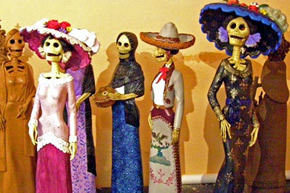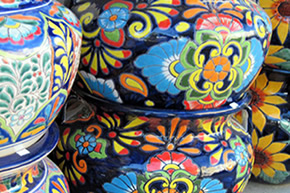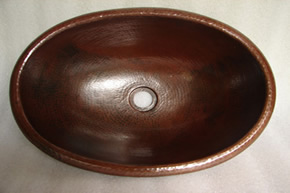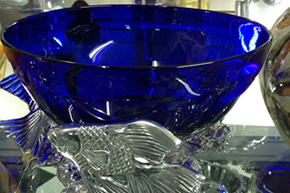The Talavera pottery has its roots in the Arab-Andalusia culture in Spain. About 8 centuries ago Arab potters settled in a location now days known as Talavera de la Reina and established and developed the techniques and procedures to create the earthenware known as Majolica.
The word Majolica originated in Italy and it refers to a process that the Italians used in the 14th Century to produce ceramics. This technique consisted basically of applying or brushing pigments on raw or unfired glaze.
Majolica was introduced in Mexico in the 16th Century, when according to the most accepted theory, Spanish monks used craftsmen imported from Talavera de La Reina to teach native artisans living in the Puebla region how to work the clay in order to craft pieces comparable to the ones produced in Spain. The monks wanted to decorate monasteries and churches with tiles and religious figures.
The prehispanic cultures of Mexico had enjoyed for long time the work of skillful native potters that produced earthenware for daily use as well as for cultural and religious purposes. However, they did not use the potter's wheel or tin-glazed their pottery. The main characteristic of majolica ceramic is precisely its beautiful glaze work.
The Mexican craftsmen blended the majolica process with their own interpretation of the method to work the clays of the region and incorporated their art forms and colors. Their product became to be known as Talavera.
Talavera ceramic is made in several parts of Mexico, but the official Talavera is only produced in Puebla. The Talavera produced in certain workshops in Puebla is now officially designated, recognized and protected by the Government of Mexico.
These Talavera manufacturers must follow a complex and strict technical fabrication process
dating from the 16th Century and use only clay from a few approved clay sites in the Puebla area.
Since the mineral pigments needed to produce the color blue were very expensive, this color was reserved for the finest ceramic. Talavera buyers could easily differentiate the quality of fine ceramic from the one of lesser quality. During the 18th Century the Talavera artisans started to broaden the designs of their ceramic by using more colors, like green, mauve and yellow, in addition to the blue tones that were very popular in the 16th and 17th Centuries.
Thanks to the artistic skills and the high quality of the clays, the Talavera form Puebla has achieved high quality and beauty. In the centuries XIX and early XX it became common for wealthy families in Mexico to have extensive collection of talavera dinner sets and decorations. Since then, it has been treasured and appreciated by collectors and admirers all over Mexico and in many other parts of the world.

Oaxacan black clay or black pottery is a traditional, pre-Columbian art form of Oaxaca, Mexico. Until the 1950s, local artisans originally used the unique local clay to create ceramic containers for the use of transporting mescal from hillside farms to sell in the local communities. Created by well-known and respected artisans in Oaxaca, Mexico...
Read More
Noble, stately and proud, La Calavera Catrina – or the "Skeleton of the Female Dandy" - has been an icon of Mexican Pop Art since the days before the Mexican Revolution. Often associated with the Mexican holiday, Día de los Muertos (Day of the Dead, November 2nd), the true history of La Catrina is one of politics and revolution...
Read More
Alebrijes are carved wooden figures created by Oaxacan artisans. They have become so popular that even the world’s most respected Spanish language authority, the La Real Academia de la Lengua Española, Spanish Royal Academy, has included the term “Alebrijes” in its official Spanish language dictionary. The term “Alebrijes” originated from...
Read More
The Talavera pottery has its roots in the Arab-Andalusia culture in Spain. About 8 centuries ago Arab potters settled in a location now days known as Talavera de la Reina and established and developed the techniques and procedures to create the earthenware known as Majolica. The word Majolica originated in Italy and it refers to a process that the Italians used...
Read More
In pre-colonial times, local Indians mined for copper in various regions of Mexico including the state of Michoacan in Central Mexico and used it to manufacture all kinds of wares and artwork. In 1538, the Spanish missionary, Vasco de Quiroga, established various schools, hospitals and libraries to educate and care for the local Indians of Central Mexico. In Michoacan...
Read More
The history of Mata Ortiz, both the village and the pottery, can be traced through the archeological remains of nearby Paquimé, a pre-Columbian city state. From its modest beginnings around 700ADE, Paquimé grew into the center of political and commercial life of the Rio Grande River Valley. By its peak in the 14th century, Paquimé boasted....
Read More
Pewter is a wonderful metal with a long history. The origin of the word Pewter is not fully known, but it is probably an English modification of the word spelter. It was adopted with only slight variation by most of the continental European nations. Some people think of Pewter as a cheap substitute for Sterling silver but this it is not. Pewter is a splendid metal...
Read More
In each country or culture where kites have been used, the people there developed special names for them. These names reflected the ideas that people had about their kites, the way they looked, or the reasons they flew them. In English, the word "kite" is also the name of a graceful bird. In Mexico, the word for kite is "papalote". That's also the Mexican...
Coming Soon

